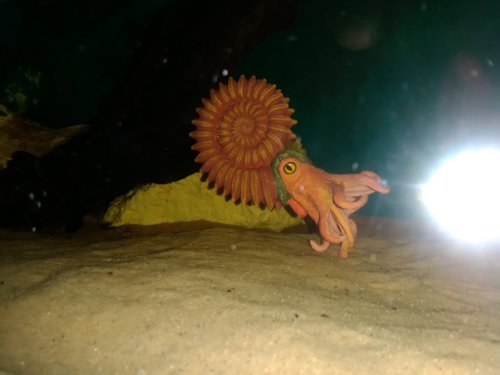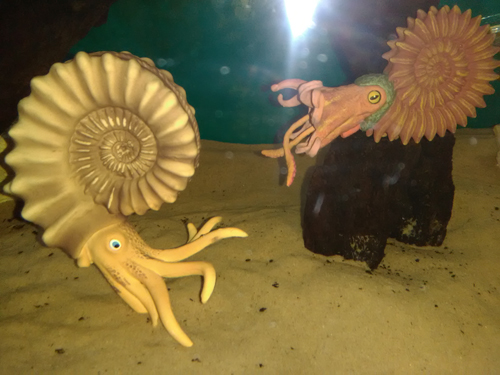An Ammonite Aquarium Model Display
At Everything Dinosaur, we get sent lots of pictures from customers of their prehistoric animal model collections. We are always most impressed with the collections and also impressed with the remarkable and innovative ways that fans of prehistoric animals display their models. For instance, model collector Paleo Paul recently emailed over to us some photographs of a couple of ammonites that he had set up to look as if these cephalopods had been photographed underwater.
An Ammonite Aquarium
The Wild Safari Prehistoric Life Ammonite on Display
Picture credit: Paleo Paul
The photograph above shows the Wild Safari Prehistoric Life ammonite replica (a model that was introduced into the range in 2014), the shot has been carefully set up to make it look like the ammonite was photographed swimming just a few centimetres from the sea bed. The use of a flash, mirrors the powerful glare of underwater search lights used by divers and the bright light helps to provide depth and shade to the image, enhancing the perspective.
To view the Wild Safari Prehistoric World model range: Wild Safari Prehistoric World Models.
It is a very clever way of showcasing a prehistoric animal replica, the ammonite model standing out and clearly defined against the sand representing the seabed and the light- coloured rock placed immediately behind the model.
To read Everything Dinosaur’s review of the Wild Safari Prehistoric Life ammonite replica: Ammonite Model Reviewed.
Two Ammonite Replicas on Display
Picture credit: Paleo Paul
The Bullyland Ammonite Model
In a second photograph, the Bullyland large ammonite model has been placed in the foreground and the two figures look really good together. The Wild Safari Prehistoric Life replica might represent one species, whilst the Bullyland ammonite figure could represent a second species. The hypernome on the underside of the Bullyland ammonite is clearly visible and the angle that the model has been placed at gives the impression that the mollusc is about to shoot backwards and speed out of the shot. Once again, it is a cleverly composed photograph with the distinctive spiral shells of the models, framed in the picture.
To view the Bullyland range of models and figures: Bullyland Prehistoric Animal Models and Figures.
Ammonite Models and Replicas
The Wild Safari Prehistoric Life ammonite is around thirteen centimetres long and the shell some six centimetres across, whereas, the rare, Bullyland ammonite is a little larger, measuring nineteen centimetres in length with a shell diameter of more than nine centimetres. The size of these models makes placing them alongside other marine animal replicas quite tricky when creating dioramas. Even if these models were to represent a very big ammonite genus, perhaps the Late Jurassic Titanites, whose fossil shells can be more than a metre across, they would still look very much out of proportion when displayed next to 1:40 scale marine reptile replicas.
We commend Paleo Paul for finding such a creative way of overcoming this problem, creating an ammonite aquarium.
Visit Everything Dinosaur’s award-winning website: Everything Dinosaur.








Leave A Comment